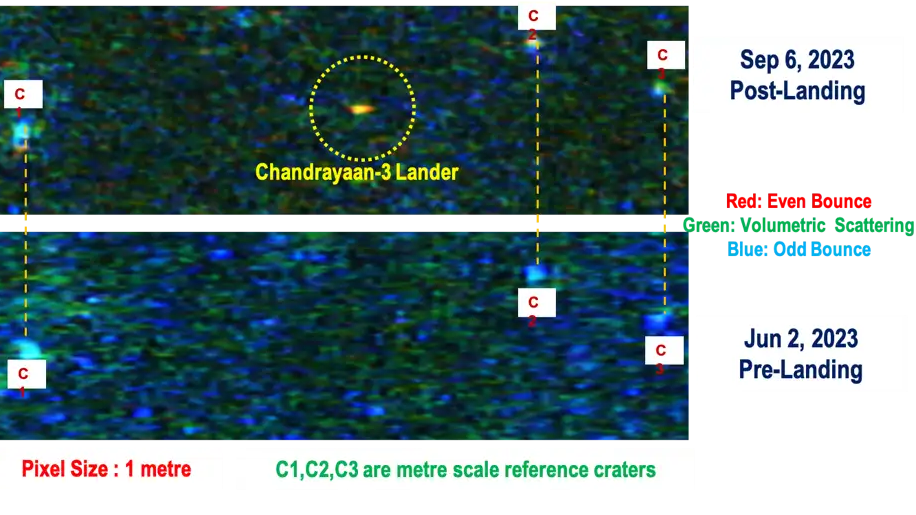
(Image credit: ISRO)
India’s new moon lander and rover were just spotted by another lunar probe.
The Chandrayaan-3 mission from India, which landed on the moon Aug. 23, shines in new pictures from a fellow spacecraft in orbit. The lander is visible in radar imagery taken by another Indian Space Research Organisation (ISRO) moon mission: Chandrayaan-2, which arrived in lunar orbit in 2019.
ISRO released the new imagery on X (formerly called Twitter) on Saturday (Sept. 9), based on data taken three days beforehand. The Chandrayaan-3 lander is not active right now, however; the near side of the moon (where the mission landed) is in darkness right now for two weeks, meaning all the solar-powered hardware is hibernating.
It may be that Chandrayaan-3’s lander and its small ridealong rover emerge from their sleep when sunlight appears again, but the duo have met all their major objectives, per ISRO officials. The rover, named Pragyan, successfully deployed from its lander, Vikram, and took pictures of the area around it.

This isn’t the first time that the Indian moon mission has been imaged from space. NASA’s Lunar Reconnaissance Orbiter, which takes high-definition imagery from the moon in orbit, captured the historic mission earlier this month.
India is only the fourth nation ever to land on the moon, following the Soviet Union, the United States and China. But more missions may be coming shortly. NASA has funded several robotic missions in support of its Artemis program, some of which may touch down as soon as 2023.

Artemis aims to establish a permanent human presence on and around the moon by the end of the 2020s.; Artemis 3 will be the first human surface mission of the series; it’s scheduled to launch late 2025 or 2026.
Numerous nations are targeting the moon’s south pole, including India, to learn more about the ice preserves that are situated there. If all goes to plan, NASA plans to set up one or more bases in this area to use the lunar ice to support its astronauts and machinery.
India isn’t the first country to try landing on the moon recently. For example, Russia attempted to send its own lander last month to the surface, but the Luna-25 probe crashed during a touchdown-setup maneuver. Attempts have also been made in recent memory by private companies in Israel and Japan, and Japan’s national space agency recently launched a moon lander called SLIM that will attempt a touchdown a few months from now.
Join our Space Forums to keep talking space on the latest missions, night sky and more! And if you have a news tip, correction or comment, let us know at: community@space.com.
Note: This article have been indexed to our site. We do not claim legitimacy, ownership or copyright of any of the content above. To see the article at original source Click Here













